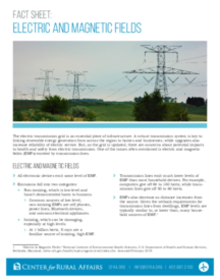Policy
The electric transmission grid is an essential piece of infrastructure. A robust transmission system is key to linking renewable energy generation from across the region to homes and businesses, while upgrades also increase reliability of electric service. But, as the grid is updated, there are concerns about potential impacts to health and safety from electric transmission. One of the issues often mentioned is electric and magnetic fields (EMFs) emitted by transmission lines.
Electric and magnetic fields
- All electronic devices emit some level of EMF.
- Emissions fall into two categories:
- Non-ionizing, which is low-level and hasn’t demonstrated harm to humans.
- Common sources of low-level, non-ionizing EMFs are cell phones, power lines, Bluetooth devices, and common electrical appliances.
- Ionizing, which can be damaging, especially at high levels.
- At 1 billion hertz, X-rays are a familiar source of ionizing, high EMF.
- Non-ionizing, which is low-level and hasn’t demonstrated harm to humans.
- Transmission lines emit much lower levels of EMF than most household devices. For example, computers give off 60 to 100 hertz, while transmission lines give off 50 to 60 hertz.
- EMFs also decrease as distance increases from the source. Given the setback requirements for transmission lines from dwellings, EMF levels are typically similar to, or lower than, many household sources of EMF.
Health effects from low-level EMF
- A 1979 study proposed a possible association between proximity to power lines and childhood leukemia, but more recent studies have not found a direct link to power lines.
- A review of more than 500 studies by the National Research Council determined that research did not show a link between EMFs commonly found in homes and health problems. The review also noted the original 1979 study did not examine other factors which may have contributed to increased cancer rates that were unrelated to EMF.
- There is no epidemiological evidence for other health consequences, and no study has found evidence of a cause and effect relationship between low levels of EMF found in household appliances or power lines and negative health effects.
Recommendations
- Developers should offer substantial opportunities for community members to weigh in on proposed projects, and use this input to identify homes and other occupied structures to address concerns about potential health effects.
- At public meetings, developers and regulators should offer EMF comparisons for stakeholders to provide context on levels from various sources.
- If landowners are concerned about the proximity of proposed transmission lines to homes and businesses, they should reach out to developers about alternatives or siting changes.


